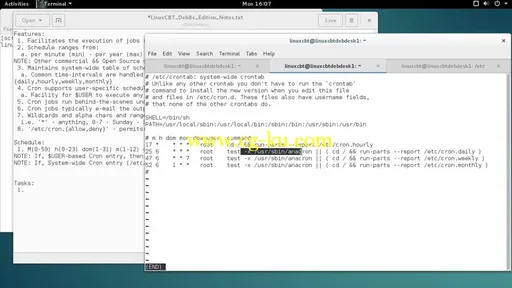
LinuxCBT Deb8x Edition
English | 2015 | mp4 | H264 1356x766 | AAC 2 ch | 16 hrs 39 min | 2.12 GB
eLearning
Course Objective
Perform Various Installations
- Discuss important release features
- Prepare virtual environment to support Debian
- Install Debian with Desktop Environment
- Evaluate updates | changes
- Perform virtualized installation with VMWare
- Confirm installation
- Clone VMWare installation
- Update cloned server deployment
- Discuss relevant settings and configuration
- Migrate to 'ifupdown' from Network Manager
- Perform startup sanity checks
- Upgrade distribution to latest stable version
- Discuss various installation techniques | benefits
- Enter Single-User mode and discuss typical usage
- Provision post-startup script invocation
Basic Debian GNU/Linux Skills
Explore usage of the following useful commands
- ls, pwd, cd, cp, mv, rm, mkdir, rmdir, whoami, tty
- cat, file, chmod, chown, history
- STDIN, STDOUT, STDERR, UNIX Pipes, Redirection, Command Chaining
- ps, df, free, top, kill
- less & more, head & tail, find
- stat, which, w, who
- dig, nslookup, host
- Archival and compression utilities with tar|gzip|bzip2
- Use checksum programs to confirm content integrity
- Explore important SSH clients for secure access
- Provision VNC GUI-enabled Remote access
- Provision Users && Groups as needed
- Evaluate effective permissions
Storage Management
- Explain common Linux file permissions
- Discuss various Linux file attributes | features
- Explore available disks with 'fdisk'
- Allocate new virtual storage for additional partitions
- Provision EXT4 File Systems on new partitions using 'parted'
- Examine default and Provision additional Swap storage
- Allocate | De-allocate SWAP as needed
- Ensure persistence across EXT4 and SWAP provisions
- Use GNOME Disks to manage storage graphically
- Explore Logical Volume Management (LVM) Configuration
- Create volume sets using: Logical Volume Management (LVM)

Screen TTYs | PTYs
- Discuss TTY | PTY limitations
- Identify opportunites to benefit from Screen
- Identify configuration environment
- Invoke and use screen natively
- Confirm persistence of TTYs | PTYs across sessions
- Share Screen sessions
- Confirm overall efficacy of Screen
Explore the CRON scheduling daemon & configuration
- Identify key Cron configuration scopes (Global & User)
- Explain Crontab file format and applicable options
- Define global cron jobs
- Define custom cron jobs user-wide
- Evaluate results of cron jobs
SYSLOG | LOG Rotation
- Explore default SYSLOG configuration
- Expose 'rsyslog' configuration
- Explore LOG Rotation configuration
- Rotate LOGs as needed
- Peruse various SYSLOG LOGs as needed
- Discuss various configurations options
SYSTEMD | INIT | Service Management
- Discuss traditional INIT model
- Explain SysV-compatibility
- Identify SysV-related scripts
- Manipulate services | daemons with: 'systemctl'
- Discuss time management via 'timedatectl' and SYSTEMD
Package Management
- Explore default APT configuration
- Identify commonly-used package management tools
- Enumerate installed packages
- Identify package owners based on system binaries
- Discuss 'apt', 'aptitude' and 'dpkg' options
- Discuss package mirrors
- Install | Remove various packages
Debian Networking
Network Tools | IP Configuration
- Use GUI to initiate common network queries
- Discuss results of initiated queries
- Examine default IP configuration
- Extend IP configuration to facilitate additional addresses
- Confirm communications
- Extend multiple addresses on various servers
- Ensure persistent IP configuration
- Configure static routes and test packet flows
DNS Configuration
- Confirm | Setup DNS services
- Test Caching-Only server responses for upstream queries
- Configure primary zone (domain) on primary DNS instance
- Confirm primary DNS instance resolves queries for managed domain (zone)
- Replicate DNS data via BIND and confirm results
- Use various resolvers to confirm resoltution of managed zone (domain)
Interface Configuration
- Explore network configuration tree
- Alter settings and evaluate
- Provision aliased interfaces as needed
- Confirm communications via various interfaces
- Committ configuration for persistence
- Provision interface configuration on various nodes
- Evaluate accordingly
Very Secure File Transfer Protocol Daemon (VSFTPD)
- Explain features and applicability
- Peruse default configuration
- Test anonymous FTP connectivity
- Secure configuration per general requirements
- Use various FTP clients to communicate with VSFTPD
- Enable local user access
- Jail users to $HOME - added security
- Evaluate results
Apache Web Service | HTTPD Server
- Implement Apache Web Server
- Explore configuration hierarchy
- Discuss key directives
- Peruse Apache logging templates and defaults
- Vary logged information as needed
- Provision IP-Based Virtual Hosts (VHosts)
- Confirm distinct IP-Based connectivity to various sites
- Contrast IP-Based sites with default sites
- Conserve IP resources with Name-Based VHosts
- Contrast various VHost types
- Secure communications with Apache SSL | TLS
- Test connectivity to various SSL|TLS-enabled sites
Debian Security
GPG Security
- Update and Upgrade install Packages
- Identify changes across Nodes
- Secure content with GNU Privacy Guard (GPG)
- Explore benefits of various Secure Shell clients
- Peruse Secure Shell Server security
- Disable superfluous services
- Explore and tighten System Policy
- Login Definitions
- Evaluate Results
NMap Security Scanner
- Obtain, compile and install current version of NMAP
- Identify commonly used NMAP options/switches/parameters
- Perform default TCP SYN-based ethical scans of local and remote resources
- Explain typical TCP handshake protocol while using NMAP
- Perform default TCP Connect-based ethical scans of local and remote resources
- Peform local ethical scans
- Identifiy key NMAP configuration files
- Use NMAP to perform operating system fingerprinting and versioning
- Peform subnet-wide ethical scans

发布日期: 2015-08-15